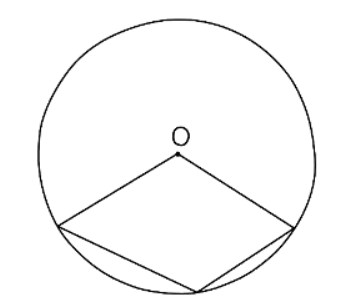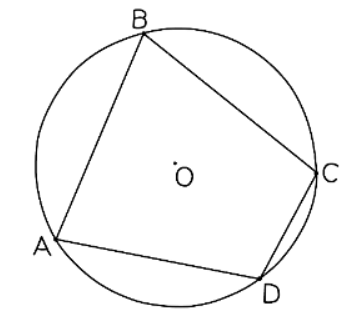Class 10 Exam > Class 10 Notes > Mathematics for GCSE/IGCSE > Cyclic Quadrilaterals
Cyclic Quadrilaterals | Mathematics for GCSE/IGCSE - Class 10 PDF Download
Cyclic Quadrilaterals
Circle Theorem: Opposite angles in a cyclic quadrilateral add up to 180°
- This theorem explains that in a cyclic quadrilateral, if all four vertices lie on the circumference of a circle, then the angles opposite to each other will sum up to 180°.
- A cyclic quadrilateral must have all its vertices on the circumference of a circle.
- The cyclic quadrilateral theorem is exclusive to cyclic quadrilaterals and does not apply to other types of quadrilaterals within a circle.
- For instance, a common scenario that does not involve a cyclic quadrilateral is depicted below:

- When utilizing the cyclic quadrilateral theorem as a reason in an examination, it is essential to incorporate key vocabulary.
- In this context, opposite angles in a cyclic quadrilateral sum up to 180°.
- The term 'supplementary' denotes angles that add up to 180° and can also be utilized with specific reference to angles within a cyclic quadrilateral.
The document Cyclic Quadrilaterals | Mathematics for GCSE/IGCSE - Class 10 is a part of the Class 10 Course Mathematics for GCSE/IGCSE.
All you need of Class 10 at this link: Class 10
|
109 videos|689 docs|60 tests
|
FAQs on Cyclic Quadrilaterals - Mathematics for GCSE/IGCSE - Class 10
| 1. How can I identify a cyclic quadrilateral? |  |
Ans. A cyclic quadrilateral is a quadrilateral where all four vertices lie on the circumference of a circle. To identify a cyclic quadrilateral, you can check if the sum of opposite angles is equal to 180 degrees.
| 2. What is the Cyclic Quadrilateral Theorem? |  |
Ans. The Cyclic Quadrilateral Theorem states that the opposite angles of a cyclic quadrilateral are supplementary, meaning they add up to 180 degrees.
| 3. Can a quadrilateral be cyclic if all its sides are equal? |  |
Ans. No, a quadrilateral with all sides equal is a rhombus, and not all rhombuses are cyclic quadrilaterals. A cyclic quadrilateral requires all four vertices to lie on the circumference of a circle.
| 4. How do I prove that a quadrilateral is cyclic? |  |
Ans. To prove that a quadrilateral is cyclic, you can show that the sum of opposite angles is 180 degrees. Another method is to show that the quadrilateral can be inscribed in a circle.
| 5. Why is understanding cyclic quadrilaterals important in mathematics? |  |
Ans. Understanding cyclic quadrilaterals is important in geometry as it helps in solving problems related to angles and circles. It also helps in proving theorems and properties of quadrilaterals.
Related Searches






















